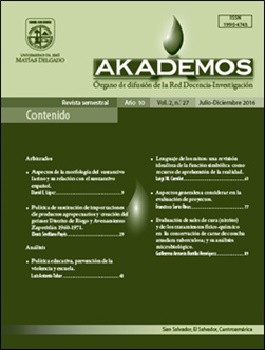Aspects of the morphology of the Latin substantive and its relation with the Spanish substantive
DOI:
https://doi.org/10.5377/akademos.v2i27.4429Keywords:
Substantive, morphology, flexion, declension, case, nominative, vocative, accusative, genitive, dative, ablative.Abstract
The so-called Neolatin languages o Romanic ones are the result of a development process, that goes from vulgar Latin or spoken Latin until it evolved into independent languages. This process started at the falling of the Roman Empire, afterward the spoken Latin of the former Roman provinces begun to acquire its own features, far away from a unique political center. In this manner were emerging French, Italian and Spanish, among other Neolatin languages.
Even though we talk about Neolatin languages as a new linguistic phenomenon, it is still remarkable in them a deep track of mother language. This mark goes beyond lexical and phonetic aspects. This track is remarkable in the substantive too, especially in semantic terms, and in its morphology as well. In spite of that Spanish lost the nominal Latin flexion, in the singular and plural form of the substantive endure the antique form of accusative Latin noun, either in singular or in plural. And in spite of what has been said, we must state that the main track of Latin morphology is to be found in the morphology of the Spanish verb.
AKADEMOS, Year 10, Vol. 2, No 27, July-December 2016: 9-28
Downloads
1420

